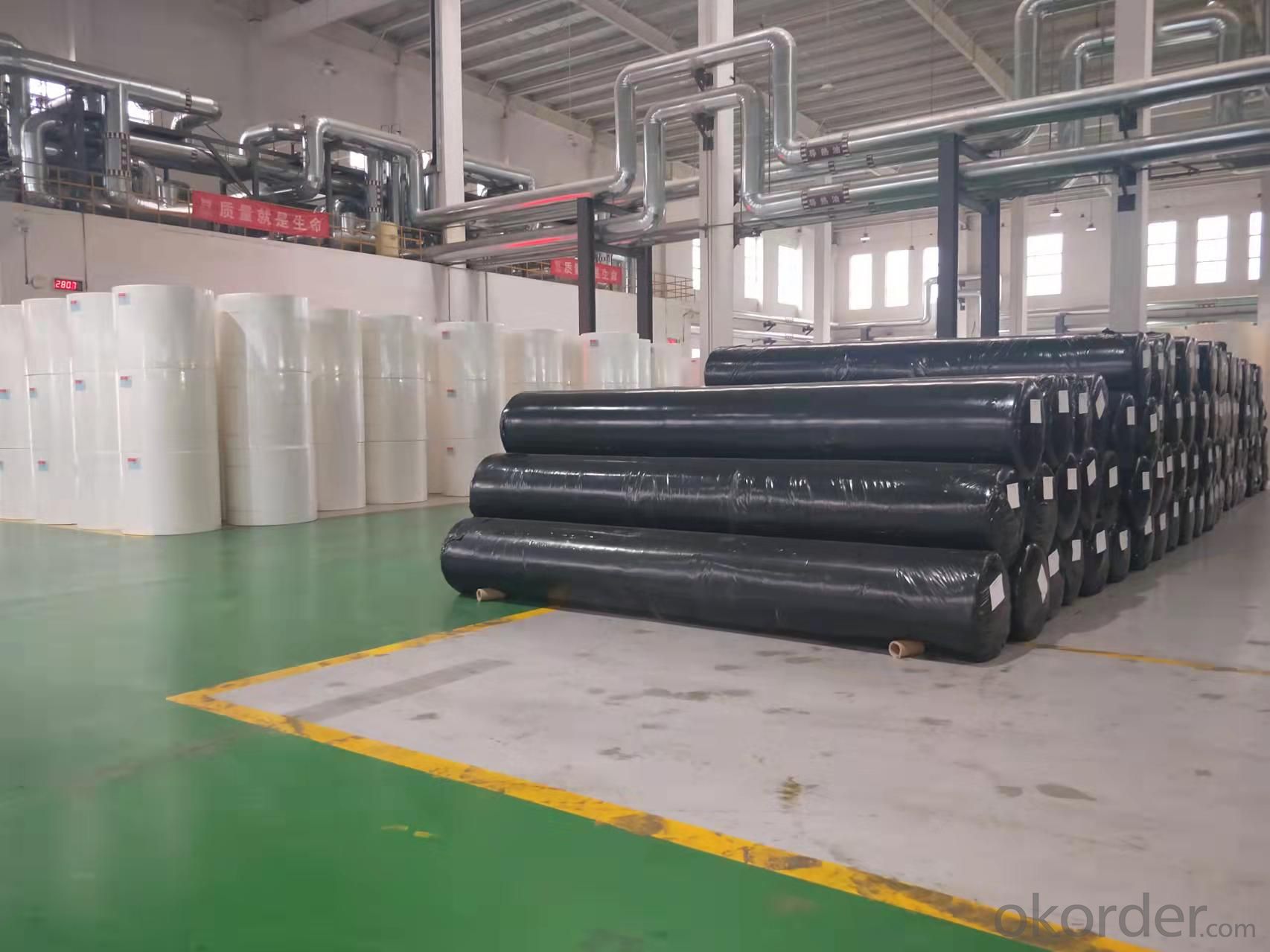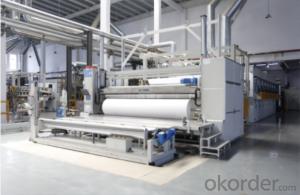polypropylene/polyester nonwovens geotextile, geosinthetic
- Loading Port:
- Shanghai
- Payment Terms:
- TT OR LC
- Min Order Qty:
- 5000 m²
- Supply Capability:
- 8000000 m²/month
- Option:
- 100-1000g/㎡
OKorder Service Pledge
Quality Product, Order Online Tracking, Timely Delivery
OKorder Financial Service
Credit Rating, Credit Services, Credit Purchasing
You Might Also Like
Product Description
POLYPROPYLENE FILAMENT NEEDLE PUNCHED GEOTEXTILE

Product Introduction:
Using high-strength polypropylene slice as the main raw material, it is produced by non-woven technology and has the functions of isolation, reinforcement, protection, filtration, drainage, and buffering.
Product specifications: TDF100~1000, width 1m~6m., length according to user requirements.
Features:
The physical and mechanical properties are 2 to 3 times higher than that of conventional products. The proportion of products with the same gram weight is low; the acid and alkali resistance is excellent, the hot melt adhesion is good, and the wear resistance is strong. It is more suitable for CRTS/ slab ballastless track sliding layer system, which can reduce the interaction between the track system and the bridge surface.
Applications:
Polypropylene needle-punched non-woven geotextile is mainly used for the sliding layer between CRTS slab ballastless track and beam surface of passenger dedicated railway, and the isolation layer between CRTS slab ballastless track and friction. It can also be widely used Hydropower, highways, railways, ports, airports, sports venues, tunnels, beaches, reclamation, environmental protection and other fields play the role of isolation, filtration, drainage, reinforcement, protection, etc.
| Iterms | Test Method | Unit | TDF6 | TDF13 | TDF22 | TDF28 | TDF35 | TDF42 | TDF50 | TDF56 | TDF65 |
| Physical Properties | - | - | Continuous filament spunbond needle punched 100% polypropylene, UV stabilized | ||||||||
| Polymer | - | - | |||||||||
| UV resistance-Tensile strength retention | ISO 10319(GB/T 15788) | After three months outdoor aging,Strength Retention>70% | |||||||||
| Chemical resistance | ISO 12960(GB/T 17632) | No effect in the range of PH2-13 | |||||||||
| Tensile Strength | ISO 10319(GB/T 15788) | kN/m | 6.0 | 13 | 22 | 28 | 35 | 42 | 50 | 56 | 65 |
| Elongation at Max Tensile Strength | ISO 10319(GB/T 15788) | % | 50-120 | ||||||||
| CBR Puncture Resistance | ISO 12236(GB/T 14800) | N | 1000 | 2100 | 3200 | 4200 | 5500 | 6500 | 7600 | 8700 | 10000 |
| Trapezoid Tear Strength | ISO 9073-4(GB/T 13763) | N | 200 | 500 | 700 | 900 | 1100 | 1200 | 1300 | 1400 | 1600 |
| Fall Cone Penetration Aperture(dia) | ISO 13433(GB/T 17630) | mm | 34 | 27 | 20 | 17 | 14 | 11 | 9 | 7 | 5 |
| Equivalent Aperture(dry sieving)(O90) | GBT 14799 | mm | 0.3 | 0.2 | 0.11 | 0.1 | 0.07 | 0.07 | 0.06 | 0.05 | 0.05 |
| Vertical Flow Rate(50mm Spout) | ISO 11058(GB/T 15789) | l/m2/s | 40 | 40 | 40 | 35 | 25 | 15 | 15 | 10 | 10 |
| vertical permeability coefficient | ISO 11058(GB/T 15789) | m/s | 2×10-1 | 2×10-1 | 2×10-1 | 2×10-1 | 2×10-1 | 1.5×10-1 | 9×10-2 | 6×10-2 | 3×10-2 |
| In-plane Water Flow 20kPa | ISO 12958(GB/T 17633) | l/m.h | 2×10-4 | 8×10-4 | 1×10-3 | 1×10-3 | 1×10-3 | 1×10-3 | 1×10-3 | 1×10-3 | 1×10-3 |
| Mass Unit Area | ISO 9864(GB/T 13762) | g/m2 | 100 | 200 | 300 | 400 | 500 | 600 | 700 | 800 | 1000 |
| Thickness 2kPa | ISO 9863-1(GB/T 13761.1) | mm | 0.8 | 1.6 | 2.2 | 2.8 | 3.3 | 3.8 | 4.1 | 4.5 | 5.0 |
| Grip Strength | ASTM D 4632(GB/T24218.18) | N | 400 | 1000 | 1500 | 2000 | 2500 | 3000 | 3500 | 4000 | 5000 |
| Elongation at Grip Strength | ASTM D 4632(GB/T24218.18) | % | 50-120 | ||||||||
| Punchture Resistance | ASTM D 4833(GB/T 19978) | N | 170 | 350 | 520 | 650 | 800 | 950 | 1050 | 1200 | 1400 |
| Permeability | ISO 11058(GB/T 15789) | s-1 | 1.0 | 1.0 | 1.0 | 0.5 | 0.4 | 0.25 | 0.2 | 0.1 | 0.05 |
| Product Specifications (Width) | GB/T 4666 | mm | 4000-5500 | ||||||||
| Fiber Fineness | GB/T 10685 | dtex | 4-15 | ||||||||
- Q:Are geotextiles commonly used in canal bank protection?
- Yes, geotextiles are commonly used in canal bank protection.
- Q:Can geotextiles be used in mine tailings dam construction?
- Yes, geotextiles can be used in mine tailings dam construction. Geotextiles are commonly used as a geosynthetic material in various civil engineering applications, including dam construction. In the case of mine tailings dam construction, geotextiles can provide reinforcement, filtration, and drainage properties to enhance the stability and performance of the dam. They can help prevent soil erosion, control water flow, and improve the overall integrity of the structure.
- Q:Woven geotextile is not considered a spinning geotextile
- Woven geotextile is made of textile technology is a spinning geotextile.
- Q:Do you want to use glue to connect the geotextile?
- Shuo earth geotextile production of drainage board geotextile, Manager Li
- Q:Can geotextiles be used in underground construction applications?
- Yes, geotextiles can be used in underground construction applications. Geotextiles are commonly used in underground construction for various purposes such as soil stabilization, drainage, filtration, and erosion control. They help to improve the overall performance and longevity of underground structures by providing reinforcement and preventing the migration of fine particles.
- Q:Do geotextiles require regular maintenance?
- Yes, geotextiles generally require regular maintenance to ensure their effectiveness and longevity. This may include inspecting for any damage or wear, removing any debris or vegetation that may accumulate on the surface, and addressing any soil erosion or drainage issues that may arise. Regular maintenance helps to preserve the integrity and functionality of geotextiles in various applications such as erosion control, filtration, and stabilization.
- Q:Are geotextiles resistant to hydrolysis?
- Yes, geotextiles are generally resistant to hydrolysis. Geotextiles are engineered materials made with synthetic fibers, such as polyester or polypropylene, which are resistant to the chemical breakdown caused by hydrolysis. This resistance allows geotextiles to maintain their strength and durability when exposed to moisture and water over time.
- Q:Are geotextiles suitable for use in landfill applications?
- Yes, geotextiles are suitable for use in landfill applications. They are commonly used as a protective layer to separate different materials in landfills, providing filtration and drainage capabilities. Geotextiles help prevent the mixing of waste materials, facilitate leachate collection, and enhance overall stability and performance of landfills.
- Q:How do geotextiles improve the performance of geocomposites?
- Geotextiles improve the performance of geocomposites by providing reinforcement, filtration, and separation functions. They enhance the strength and stability of the geocomposite structure, prevent soil erosion and migration, and promote the efficient drainage of water and other fluids.
- Q:Can geotextiles be used in geosynthetic clay liner applications?
- Yes, geotextiles can be used in geosynthetic clay liner applications. Geotextiles are often used as a protective layer or separator over the geosynthetic clay liner to prevent clogging and enhance the overall performance of the liner system.
1. Manufacturer Overview |
|
|---|---|
| Location | |
| Year Established | |
| Annual Output Value | |
| Main Markets | |
| Company Certifications | |
2. Manufacturer Certificates |
|
|---|---|
| a) Certification Name | |
| Range | |
| Reference | |
| Validity Period | |
3. Manufacturer Capability |
|
|---|---|
| a)Trade Capacity | |
| Nearest Port | |
| Export Percentage | |
| No.of Employees in Trade Department | |
| Language Spoken: | |
| b)Factory Information | |
| Factory Size: | |
| No. of Production Lines | |
| Contract Manufacturing | |
| Product Price Range | |
Send your message to us
polypropylene/polyester nonwovens geotextile, geosinthetic
- Loading Port:
- Shanghai
- Payment Terms:
- TT OR LC
- Min Order Qty:
- 5000 m²
- Supply Capability:
- 8000000 m²/month
- Option:
- 100-1000g/㎡
OKorder Service Pledge
Quality Product, Order Online Tracking, Timely Delivery
OKorder Financial Service
Credit Rating, Credit Services, Credit Purchasing
Similar products
New products
Hot products
Related keywords































